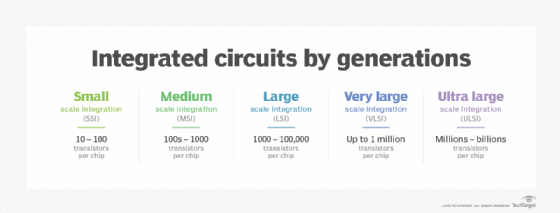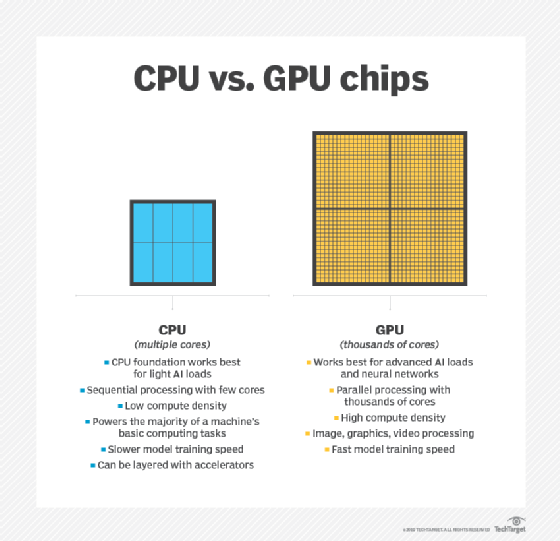What is a complementary metal-oxide semiconductor (CMOS)? | Definition from TechTarget
A complementary metal-oxide semiconductor (CMOS) is the semiconductor technology used in most of today’s integrated circuits (ICs), also known as chips or microchips. CMOS transistors are based on metal-oxide semiconductor field-effect transistor (MOSFET) technology. It is called complementary because each element is made up of two transistors working together in a complementary pair.
What are the two types of transistors in CMOS?
MOSFETs use semiconductor materials to conduct electricity under certain conditions but not others. A semiconductor falls somewhere between a conductor and insulator in terms of conductivity. It typically consists of silicon and a mix of impurities that together strike the right balance of conductivity. Silicon in its pure form is not conductive. MOSFETs serve as switches or amplifiers that control the amount of electricity flowing between source and drain terminals, based on the amount of applied voltage.
The process of adding impurities to a material such as silicon is sometimes referred to as doping. Semiconductor doping can be applied in different degrees to control conductivity. However, other factors can also impact conductivity, such as the type of impurities used.
In MOSFETs, the impurities used for the semiconductor material depend on the semiconductor type. MOSFET semiconductors fall into one of two categories: p-type or n-type. Boron, gallium and indium are commonly used for p-type semiconductors. Phosphorus, arsenic and bismuth are commonly used for n-type semiconductors.
The p-type semiconductor, which is positively charged, carries current as electron deficiencies called holes. A hole has a positive charge that is equal to and opposite an electron charge. The electrons flow in a direction opposite the holes. The n-type semiconductor is negatively charged. In this case, the semiconductor carries current in the form of negatively charged electrons.

Why is CMOS complementary?
There are two primary types of MOSFET transistors: p-channel MOS and n-channel MOS. Both PMOS and NMOS transistors use p-type and n-type semiconductors. In a PMOS transistor, the source and drain use a p-type semiconductor, and the substrate uses an n-type semiconductor. An NMOS transistor takes the opposite approach. The source and drain use an n-type semiconductor, and the substrate uses a p-type semiconductor.
Before the introduction of CMOS, PMOS and NMOS were widely used in electronic devices. NMOS eventually became the favored approach to integrated circuitry because it was faster and cheaper to produce, although it was not without its own limitations, such as its static power consumption.
CMOS addressed the issues inherent in PMOS and NMOS by incorporating both types in a single IC that contains symmetrical (complementary) PMOS-NMOS pairs. When used together, the two types of transistors provide greater flexibility in circuitry design, while reducing power draw and susceptibility to electronic noise.

Another advantage of complementary PMOS-NMOS pairs is that they require less power. This is because current is applied briefly when switching between on and off states. In fact, CMOS ICs use almost no power during static conditions. By extension, the lower power consumption also means that CMOS-based ICs generate less heat, compared to those based on either PMOS or NMOS alone.
Because power consumption and heat generation are two major factors in designing high-performance ICs, CMOS logic is now widely used in microprocessors, microcontrollers, static RAM, image sensors and other ICs. By all accounts, its use will continue to dominate the industry.
What is CMOS in computers?
The computer BIOS or Unified Extensible Firmware Interface (UEFI) stores the low-level configuration for the computer in a CMOS chip. Many people refer to the computer’s BIOS or UEFI as the CMOS. Because the chip requires power to store the settings, the motherboard will have a battery to provide constant power to keep the settings and power the built-in clock. This battery is often called the CMOS battery, and to reset the motherboard settings may be called “clearing the CMOS.” A dead CMOS battery can cause the computer to give errors on Power-On Self-Test or lose the current time.
CMOS sensors
Digital cameras use an IC as the sensor to collect and measure the light. There are two major types of sensors in use, CMOS sensors and charged coupled device (CCD).
CMOS sensors are cheaper and easier to produce, so they are used in most digital photography applications. CCD is more sensitive and less susceptible to noise, so it is used for scientific or high-performance applications.
Learn about fan-out in digital circuitry, which is a measure of the maximum number of digital inputs the output of a single logic gate can feed without disrupting circuitry operation. Explore our flash memory guide to architecture, types and products and explore the differences between cache vs. RAM. Explore the essentials of buying server hardware, including what you need to know about server motherboards.



